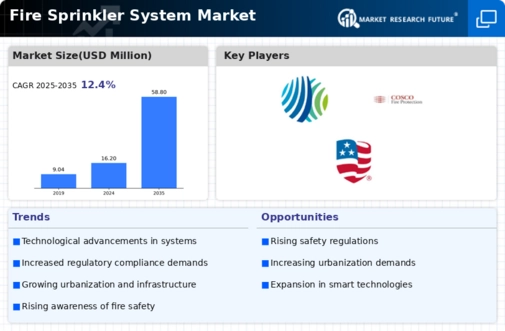Market Analysis
In-depth Analysis of Fire Sprinkler System Market Industry Landscape
The global fire sprinkler system market is set to reach US$ 21223.2 MN by 2032, at a 12.4% CAGR between years 2023-2032. Of the segment of industries encompassed by fire protection, one critical market is that of Fire Sprinkler Systems whose dynamics provide a unique set of markers for its development and path. Arguably, the focal area that has an immense impact on market dynamics is that of fire safety and how critical it is in different industries. As more and more businesses, residential complexes, and industrial skeletons have increased need to guarantee the safety of occupants as well as their goods business entities continue enhancing efforts to increase demand for reliable and effective fire protection systems formulated in line with modern technologies including application of fire sprinkler systems. This consumer driven safety focus stimulates constant change and innovation in the Market for the Fire Sprinkler Systems resulting to emergence of new technologies aimed at improving the performance on detection, response, and control fire related incidents. At the same time, technology novelty is one of the main drivers for market dynamics. Fire sprinkler systems are becoming progressively better, beyond typical designs involving intelligent technologies, advanced materials and innovate water distribution mechanisms. However, the areas where modern systems come in handy contain a number of sensors installed along with IoT connectivity and also intelligent control panels which allow one to have an eye on the fire real time basis and informed response almost instantly. The technologization of technology does not only increase the operating efficiency of fire sprinklers but also ties it as an inseparable part from overall fire protection strategies. The markets are also affected by regulatory frameworks, building codes which in international se looks as a dynamic global market. The local governments and the regulatory bodies set high standards in regards to safety, involving the inclusion of fire protection facilities to be installed across several structures. This has emerged as the major contributor for increasing demand within proper segment of fire sprinkler system market. Adherence to these regulations is propelling businesses and property owners towards installing qualified fire sprinklers systems, thereby contributing to overall growth in the concerned Regulatory changes, for instance, revisions in codes of building or new standardization safety standards can have a profound impact on market dynamics. Such regulatory changes tend to compel adopting specific technology or design modifications within the market. The market medicine is a very complicated eco-system that include manufacturers, installers, inspection and maintenance service providers as well as regulatory boards. In this integrated world Collaborations between companies and partnerships allow them offer a complete set of solutions that cover the process of choosing system designs, installation, and constant maintenance. As a matter of fact, these efforts and even some of the strategies towards fire protection cover not only different specific segments, but whole variety forms the very fire development itself.






Leave a Comment